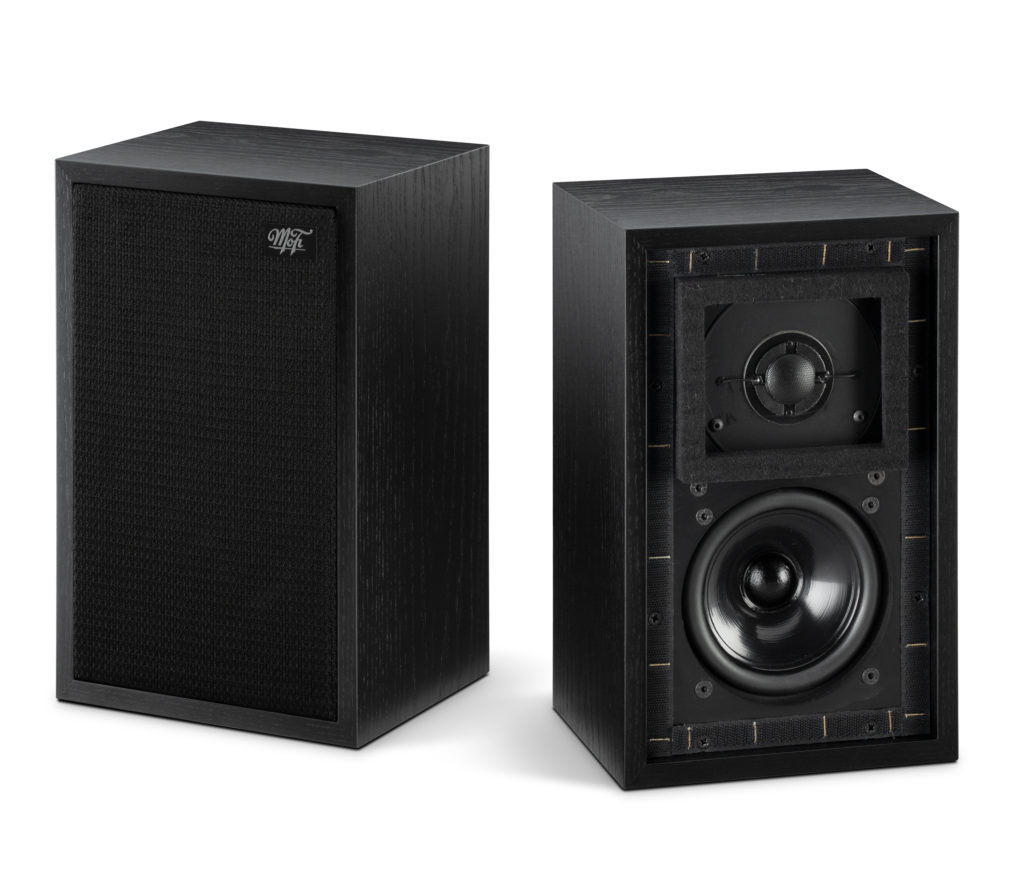
The MoFi Edition LS3/5a Monitor Loudspeakers by Falcon Acoustics ($1,995) are the lowest-priced version of the BBC officially licensed LS3/5a available in the US market. At one thousand dollars less than their gold-badge counterparts, the MoFi edition features an understated but well-executed black ash real-wood veneer. Aside from visual changes, they are functionally the same as the original Falcon Acoustics silver-badge LS3/5a model.
The fact that they are functionally the same is a good thing. They feature the same custom Falcon drivers developed by Malcolm Jones, former Senior Development Engineer at KEF responsible for the original B110 woofer and T27 tweeter used in the original LS3/5a.
Exclusive to the US Market
MoFi’s objective in bringing the LS3/5as exclusively to the US market was to expose a wider number of audiophiles and music lovers to these classic speakers. By lowering the cost of entry, more people can experience these speakers and maybe even fall in love with what they have to offer.
I had never heard the LS3/5a, P3ESR, or any other variation of the classic BBC mini-monitor, I had no expectations when I put the MoFi Edition LS3/5as into my system. I took a close look at exactly what you get for $2,000, and then listened to their signature sound. Read on to find out how this design from the 1970s holds up to today’s tough competition.
What’s Old is New Again
Modern speaker designs are constantly evolving and advancing their cabinet materials, drivers, acoustic performance, and crossover designs. Falcon Acoustics’ goal with the LS3/5a is the opposite. The company is instead faithfully reproducing the original BBC design published in 1976. Furthermore, it’s officially licensed by the BBC. This means the LS3/5a uses the original 15-ohm FL6/23 filter network featuring British-made inductors.
The internally-damped cabinet also mirrors the original design, featuring specifically graded half-inch Baltic Birch plywood with Beech fillets. The designers chose these materials for their acoustics properties and their resonant frequencies. The BBC wanted a cabinet that didn’t color the sound. The well-made cabinet isn’t going to win any awards for outstanding appearance, but this isn’t a speaker to look at.
Sound Signature and Performance
I connected the MoFi LS3/5as to my Norma Audio REVO IPA-140 integrated amplifier and played them at low levels for 100 hours with a mix of internet radio and my local Jazz FM radio station. When I sat down to take a close listen, I was somewhat surprised. Nothing about the sound I heard was “vintage” or “old”. If I was listening blind, I wouldn’t have realized this was a small bookshelf speaker design from 1976. I was impressed by their imaging performance, which compared admirably to other speakers I’ve heard at this price and higher.
For a vintage speaker design, the LS3/5as have a detailed treble presentation. There’s enough shimmer and brilliance to convey even the most subtle and nuanced high-frequency detail. However, with some recently mastered music, the tweeter could be a little bright and assertive. When I switched to higher-quality recordings, the tweeter performed exactly as it should, filling out the upper-frequency range accurately, without bringing attention to itself.
The frequency response of the LS3/5a is only rated down to 70hz. They don’t dig extraordinarily deep. Nonetheless, they did have better bass than I expected for a speaker of this size. They represented low frequencies and basslines with agility and tonal accuracy. I threw a bevy of modern drum ‘n’ bass tracks at them, just to see how low they could go. I was pleased that they seemed to respond below 70hz, albeit with a somewhat thin and restrained quality. If electronic music is your top priority, then bolstering the low-frequency response with a high-quality eight- or ten-inch subwoofer would be worthwhile.
The midrange is where the magic happens with the MoFi LS3/5as. This was immediately apparent when I played some well-recorded tenor-saxophone jazz. I suddenly understood what all the hype was about, and why these speakers have such an enthusiastic fanbase. Woodwind instruments sounded rich and palpable, not syrupy or sluggish. There was a perfect balance of agility and warmth that captivated me. It made me listen to every second of a song, without feeling like I wanted to skip ahead to something else.
Outstanding Vocals
I selected three different songs to evaluate the LS3/5a’s performance with voices. Despite how dissimilar each song is, I could have sworn I was standing in the recording booth with the singer. The tonal accuracy, nuance, and overall realism were all remarkable.
Nine Inch Nails – Hurt
Describing Hurt, Trent Reznor said to Alternative Press magazine, “I wrote some words and music in my bedroom as a way of staying sane, about a bleak and desperate place I was in.” The Falcons let me hear the soul-crushing despair and anguish that were on the tip of his tongue when he recorded this intimate performance. They provided un-colored insight into the texture, restraint, and subtlety of Trent’s haunting lyrics. It was the most impactful rendition of this emotionally distressing song I’ve ever heard.
Frank Sinatra – Strangers In The Night
Frank Sinatra’s iconic and unmistakable voice make this song a useful test of a speaker’s accuracy and realism. The MoFi LS3/5as projected his voice without any coloration or unnatural chestiness. I could hear the subtle vocal intonations within Sinatra’s voice as he sang this inspirational story about a life-changing meeting between two strangers in the night. His voice stayed perfectly focused between the two speakers, while the other instruments filled out the rest of the wide soundstage.
Eliane Elias – Estate
Brazilian-born musician Eliane Elias sings in Italian on this cover of Bruno Martino’s “Estate” from 1960. Her voice intertwined seamlessly with the lush and romantic orchestral swells as if it were another instrument. The Falcon speakers excelled at conveying the delicacy of Elias’ singing. I closed my eyes and let the LS3/5as transport me to another time and space.
The British Connection
“It don’t mean a thing if it ain’t got that swing.” That’s how I felt about my second amplifier pairing, the Cambridge Audio Azur 851a integrated. It must have been the British synergy, because this amplifier took the Falcon speakers’ already impressive imaging to a new level. The sound was airy, wide, and expansive. The sweet spot was large and didn’t waver, providing several cohesive layers of sound to explore.
I also noticed the impeccable rhythm and timing. I couldn’t help but nod my head and tap my foot along with the music. This agility worked especially well with jazz rhythms and gave me the feeling that I could keep listening for hours. This synergy between speaker and amplifier was a simple pleasure that put a smile on my face — it just sounded right.
Tubes and Vinyl
The third and most successful pairing was the MastersounD BoX tube integrated amplifier. The depth, layering, tonality, and bold sound was captivating. Each element within a song had its own space to expand into, presenting a tall and wide holographic soundstage. This was the biggest sound I’d heard coming from these diminutively sized Falcon speakers.
The 35wpc was more than enough for these speakers to shine, even with musical transients and dynamic peaks. With both vinyl and digital sources, there was a pleasant liquidity to the sound without sounding “tubey” or slow. It was less “audiophile” and more musical than the other pairings, without giving up any detail retrieval. Whether it was vinyl, SACD, or streaming Qobuz, listening with the BoX took me out of reviewer mode and left me captivated by the music.
Closing Thoughts
The time I spent with the Falcon Acoustic LS3/5a MoFi edition speakers showed their versatility with amplifier pairings. Across my three test amps, their outstanding imaging and spot-on tonality jumped out at me. After listening for several months, I now understand what makes these speakers so special with vocals and intimately recorded instruments. It’s truly is a “once you hear it, you understand it” situation.
This is a specialty speaker which will appeal to a specific type of listener. It’s important to remember that they will excel at certain genres and not others. If your listening tastes align with the LS3/5a’s strengths, you’re in for a genuine reward. Another boutique speaker which is a natural competitor at $2k is the Margules Magenta Studio Monitors. These rear-ported monitors lead with strong bass energy and have a tweeter that can be listened to all day long. Strong performers in all musical genres, they get the hat tip for musical versatility. Conversely, the Falcon Acoustics speakers have more midrange insight and a drier, more balanced sound.
For smaller rooms, the MoFi LS3/5as are a solid choice. They adapt well to tight spaces and room boundaries thanks to their acoustic suspension design. These speakers and vinyl go together like bread and butter. They do a fantastic job of showcasing the smooth and delicate sonic beauty of vinyl playback. Lastly, their power handling and amplifier compatibility means they will pair up well with many different types of amps.
For critical listening with a focus on tonal accuracy and the reproduction of the human voice, the Falcon Acoustic LS3/5a MoFi edition speakers may have no true opponent. They simply do what they set out to do – provide an exacting modern-day reproduction of the classic BBC minimonitor design from 1976. Every music lover should hear a pair of these speakers at some point in their life.

